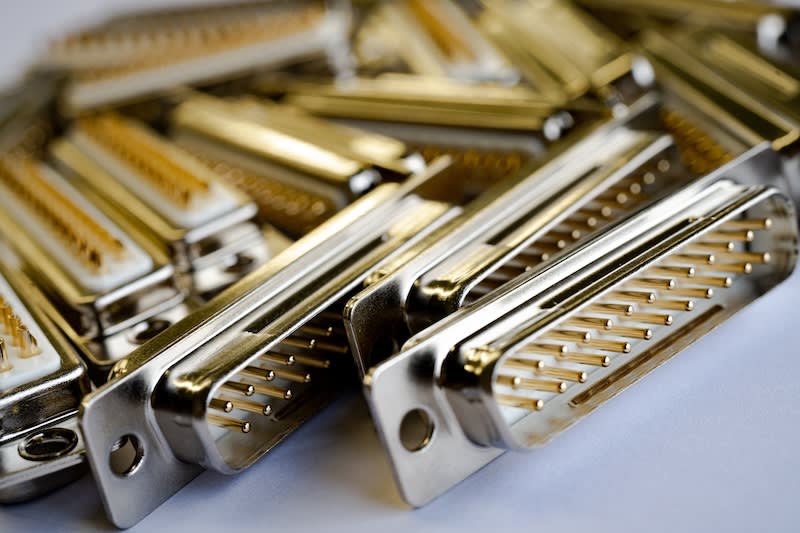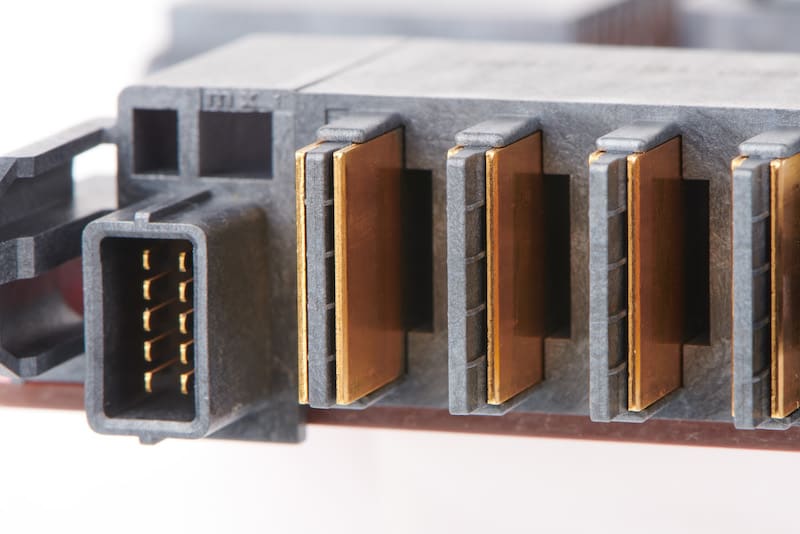Beyond the Pin and Socket
Suivez l'articleQue pensez-vous de cet article ? Aidez-nous à vous fournir un meilleur contenu.
Merci! Vos commentaires ont été reçus.
There was a problem submitting your feedback, please try again later.
Que pensez-vous de cet article ?
The contact or terminal is at the very heart of connector design, both physically and functionally. It is the terminal that enables the connector to perform its role – to join two electrical circuits together. The traditional male and female arrangement of electrical contacts has been a constant feature of connector design, in which a fixed male pin is accommodated in a female socket. The socket is slightly compliant and features a smaller internal dimension than the size of the corresponding pin. In this way, as the pin is inserted into the socket, a force is applied to it to ensure good electrical continuity. This positive spring pressure, called the normal force, also helps to grip the pin so that it does not shake loose under vibration or everyday use.
Traditional pin and socket connectors
While the exact design of the pin and socket arrangement varies widely depending on their size and intended purpose, many of the millions of connectors that have been produced over the years have used this technology. From the original cylindrical connector used in telephone exchanges to the complex multi-pin connectors that provide communication for the latest airliner, the conventional pin and socket has proven its reliability many times over.
However, one of the most fascinating aspects of the interconnect industry is the huge variety of designs it offers – the ever-popular pin and socket is just one of the alternatives available. In this series of articles, we will look at some of the other contact designs on the market and try to understand why they might be a good solution for your next project.
Low Resistance
When transmitting power, size is vitally important. If we compare electrical circuits to pipes and plumbing, the larger the pipe, the greater its capacity. The large cross-sectional area allows a greater rate of flow and reduces pressure. Conversely, a narrower pipe restricts the flow, just as a resistor limits the flow of electricity. For the same reason, the terminals of power connectors feature large conductors to keep resistance as low as possible.
Many power connectors use circular pins. If they are machined from a solid bar, they offer a good cross-sectional area and a low resistance. There is a reason why a lot of circular connector designs use solid pins such as these, from industrial connectors like the Bulgin Buccaneer series (344-4021) to military types including the ever-popular MIL-DTL-38999 such as this example from Amphenol (875-1551) . Machined terminals are also closely associated with high reliability, which is another reason for their popularity.
The alternative to machined contacts is provided by stamped-and-formed construction. These are created by folding a flat sheet of metal into a 3-dimensional shape, creating a terminal that is suitable for use in a connector. Suitable for the mass market, stamped and formed contacts are cheap to manufacture. However, their drawback when used as a power terminal is that the cross-sectional area is limited by the thickness of the original sheet. When folded into a circular pin, they are hollow.
If size was the only important consideration of power terminal design, stamped and formed pins might not ever be considered for high-current applications. However, large cross-sectional area is not the only vital attribute of a power connector. The other is governed by the geometry of the contact between the two terminals. A successful power terminal maximises the contact surface area between the two terminals. While cylindrical pin terminals have a large cross-section that is ideal for carrying a large current, they are limited by the area of contact between the male and female halves.
Power Blades
In contrast, while blade terminals with a smaller cross-section and a lower current rating, they boast a large surface area for contact between the two halves. Their slim profile is another advantage that is increasingly useful in today’s space-constrained applications. PCB-mounted power connectors have always been important in rack-mounted applications. In today’s data centre installations, board-mounted connectors are usually rectangular. These long, slim connectors can mount a larger number of blade terminals than if using circular pins, even though individually they offer a lower current rating.
The designer therefore needs to consider power density. It is possible to obtain a better total current rating with connectors that use a larger number of smaller terminals, and in that way, a blade terminal may be more efficient than a cylindrical pin. Many manufacturers are offering PCB-mounted power connectors that take advantage of the blade terminal. Molex with its EXTreme High-current connector system (729-6078) and Samtec’s mPOWER® connector (187-2167) both maximise power density by using blade terminals.
Blade terminals installed in the EXTreme Ten60Power connector from Molex
The slim design of blade terminals offers another advantage for the modern designer. Heat is becoming a serious concern in today’s data centre. The conventional pin is less efficient for dissipating the heat associated with power than the larger surface area of the blade terminal. Some designs are even taking advantage of the shape of blade terminals by leaving cavities in connector housings to allow ventilation. The flow of air through these cavities can help with thermal management.
Smaller is Sometimes Better
Power connectors do not need to be bulky and cumbersome. Smaller connectors using blade terminals hold the advantage in certain situations, especially critical to satisfy the demands of the latest data centres and alternative energy generation. The same technology can be applied to almost any application within electronics. When looking for your next power connector, the blade terminal might be the solution for you.
Join us for the next part of this series, when we will turn away from power connectors and look at how alternative contact designs are enabling low-profile connectors for the latest high-speed data applications.



